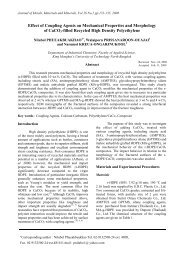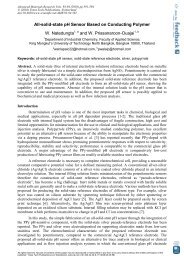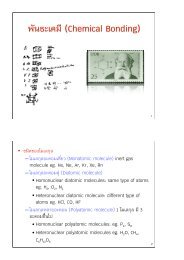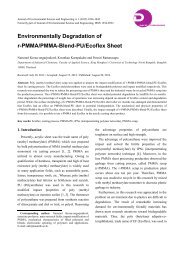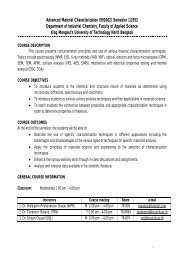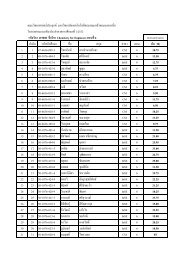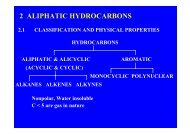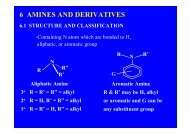Poly(2,5-dimethoxyaniline) based pH sensors Nophawan Paradee ...
Poly(2,5-dimethoxyaniline) based pH sensors Nophawan Paradee ...
Poly(2,5-dimethoxyaniline) based pH sensors Nophawan Paradee ...
You also want an ePaper? Increase the reach of your titles
YUMPU automatically turns print PDFs into web optimized ePapers that Google loves.
NU Science Journal 2009; 6(S1) 94<br />
CONCLUSION<br />
PDMA-modified electrode has been simply fabricated via a one-step<br />
electropolymerization of 2,5-<strong>dimethoxyaniline</strong> on stainless steel. The potentiometric<br />
sensitivity to <strong>pH</strong> change of the PDMA-modified electrode exhibits a response slope<br />
of 49.31 ± 6.10 mV/<strong>pH</strong> (28 o C), a linearity range from <strong>pH</strong> 2 to 8 and the response<br />
time less than 10 seconds. The PDMA-modified electrode shows a small effect to<br />
several common interfering ions. The electrode lifetime is up to 20 days. XPS<br />
investigations reveal that the potentiometric responses to <strong>pH</strong> change were related to<br />
the protonation and deprotonation of the nitrogen atoms contained in the PDMA<br />
structure. Easy fabrication and low production cost of the PDMA-modified<br />
electrodes offer an alternative to polymer-<strong>based</strong> <strong>pH</strong> <strong>sensors</strong>. Further development<br />
has been focused on modification of the PDMA surfaces in order to improve the<br />
potentiometric responses to <strong>pH</strong> change which is the work in progress.<br />
ACKNOWLEDGMENTS<br />
The authors gratefully acknowledge the Australian Research Council and<br />
the State Government of Victoria for grant assistance with the acquisition and<br />
operation of XPS instrumentation.<br />
REFERENCES<br />
Aquino-Binag, C. N., Kumar, N., Lamb, R. N. and Pigram, P. J. (1996). Fabrication and<br />
Characterisation of a Hydroquinone-funtionalised PPy Thin Film <strong>pH</strong> Sensor. Chem.<br />
Mater., 8(11), 2579-2585.<br />
Bobacka, J., Ivaska, A. and Lewenstam, A. (2008). Potentiometric Ion Sensors. Chem. Rev.,<br />
108, 329-351.<br />
Buck, R. P. and Linder, E. (1994). Recommendations for nomenclature of ion-sensitive<br />
electrodes (IUPAC Recommendations). Pure Appl. Chem., 66, 2527.<br />
Lakard, B., Segut, O., Lakard, S., Herlem, G. and Gharbi, T. (2007). Potentiometric<br />
Miniaturized <strong>pH</strong> Sensors Based on <strong>Poly</strong>pyrrole Film. Sens. Actuators B, 122, 101-<br />
108.<br />
Morita, M., Takase, H., Ishikawa, M. and Matsuda, Y. (1995). Electrocatalytic Behavior of<br />
<strong>Poly</strong>(2,5-dihydroxyaniline) Synthesized by Electropolymerization in Aqueous<br />
Solutions. Bull. Chem. Soc. Jpn., 68, 2207-2213.<br />
Perrin, D. D. and Dempsey, B. (1974). Buffers for <strong>pH</strong> and Metal Ions Control. London,<br />
Chapman and Hall.<br />
Prissanaroon-Ouajai, W., Pigram, P. J., Jones, R. and Sirivat, A. (2008). A Novel <strong>pH</strong> Sensor<br />
Based on Hydroquinone Monosulfonate-doped Conducting <strong>Poly</strong>pyrrole. Sens.<br />
Actuators B, 135, 366-374.<br />
Prissanaroon, W., Brack, N., Pigram, P. J., Hale, P., Kappen, P. and Liesegang, J. (2004).<br />
Fabrication of Patterned <strong>Poly</strong>pyrrole on Fluoropolymers for <strong>pH</strong> Sensing<br />
Applications. Synth. Met., 154(1-3), 105-108.<br />
Prissanaroon, W., Brack, N., Pigram, P. J. and Liesegang, J. (2006). Co-doped <strong>Poly</strong>pyrrole<br />
Coatings for Stainless Steel Protection. Surf. Rev. Lett., 13(2-3), 319-327.




